Lu Zhang
Tony
FairAgent: Democratizing Fairness-Aware Machine Learning with LLM-Powered Agents
Oct 05, 2025Abstract:Training fair and unbiased machine learning models is crucial for high-stakes applications, yet it presents significant challenges. Effective bias mitigation requires deep expertise in fairness definitions, metrics, data preprocessing, and machine learning techniques. In addition, the complex process of balancing model performance with fairness requirements while properly handling sensitive attributes makes fairness-aware model development inaccessible to many practitioners. To address these challenges, we introduce FairAgent, an LLM-powered automated system that significantly simplifies fairness-aware model development. FairAgent eliminates the need for deep technical expertise by automatically analyzing datasets for potential biases, handling data preprocessing and feature engineering, and implementing appropriate bias mitigation strategies based on user requirements. Our experiments demonstrate that FairAgent achieves significant performance improvements while significantly reducing development time and expertise requirements, making fairness-aware machine learning more accessible to practitioners.
A Generative Foundation Model for Chest Radiography
Sep 04, 2025Abstract:The scarcity of well-annotated diverse medical images is a major hurdle for developing reliable AI models in healthcare. Substantial technical advances have been made in generative foundation models for natural images. Here we develop `ChexGen', a generative vision-language foundation model that introduces a unified framework for text-, mask-, and bounding box-guided synthesis of chest radiographs. Built upon the latent diffusion transformer architecture, ChexGen was pretrained on the largest curated chest X-ray dataset to date, consisting of 960,000 radiograph-report pairs. ChexGen achieves accurate synthesis of radiographs through expert evaluations and quantitative metrics. We demonstrate the utility of ChexGen for training data augmentation and supervised pretraining, which led to performance improvements across disease classification, detection, and segmentation tasks using a small fraction of training data. Further, our model enables the creation of diverse patient cohorts that enhance model fairness by detecting and mitigating demographic biases. Our study supports the transformative role of generative foundation models in building more accurate, data-efficient, and equitable medical AI systems.
\(X\)-evolve: Solution space evolution powered by large language models
Aug 11, 2025



Abstract:While combining large language models (LLMs) with evolutionary algorithms (EAs) shows promise for solving complex optimization problems, current approaches typically evolve individual solutions, often incurring high LLM call costs. We introduce \(X\)-evolve, a paradigm-shifting method that instead evolves solution spaces \(X\) (sets of individual solutions) - subsets of the overall search space \(S\). In \(X\)-evolve, LLMs generate tunable programs wherein certain code snippets, designated as parameters, define a tunable solution space. A score-based search algorithm then efficiently explores this parametrically defined space, guided by feedback from objective function scores. This strategy enables broader and more efficient exploration, which can potentially accelerate convergence at a much lower search cost, requiring up to two orders of magnitude fewer LLM calls than prior leading methods. We demonstrate \(X\)-evolve's efficacy across three distinct hard optimization problems. For the cap set problem, we discover a larger partial admissible set, establishing a new tighter asymptotic lower bound for the cap set constant (\(C \ge 2.2203\)). In information theory, we uncover a larger independent set for the 15-vertex cycle graph (\(\mathcal{C}_{15}^{\boxtimes 5}\), size 19,946), thereby raising the known lower bound on its Shannon capacity. Furthermore, for the NP-hard online bin packing problem, we generate heuristics that consistently outperform standard strategies across established benchmarks. By evolving solution spaces, our method considerably improves search effectiveness, making it possible to tackle high-dimensional problems that were previously computationally prohibitive.
Regularizing Subspace Redundancy of Low-Rank Adaptation
Jul 28, 2025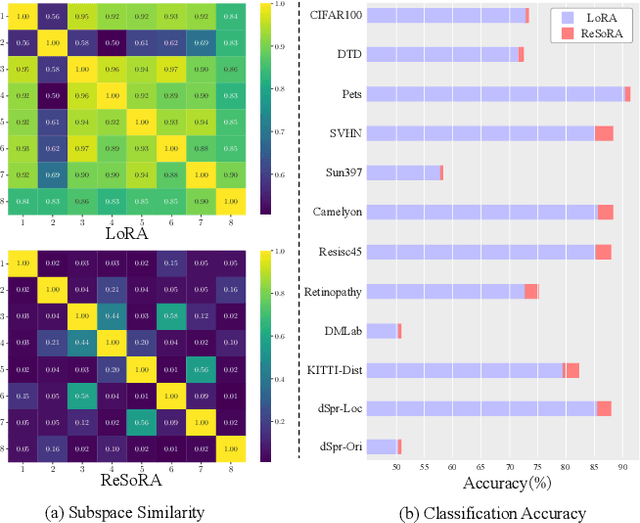

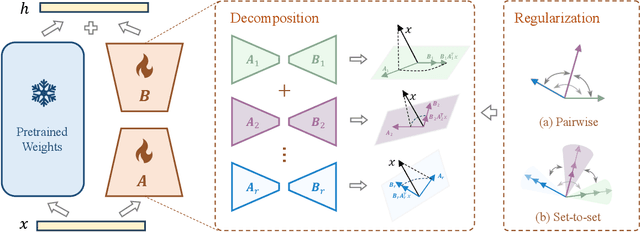
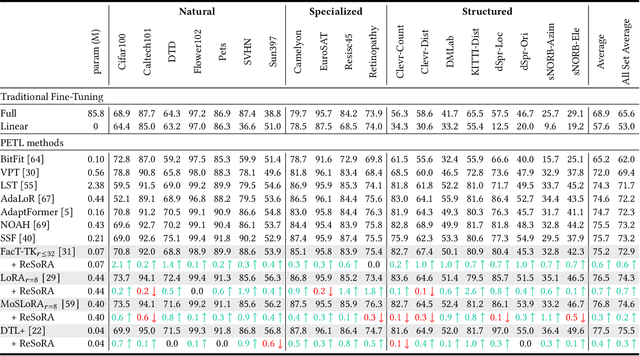
Abstract:Low-Rank Adaptation (LoRA) and its variants have delivered strong capability in Parameter-Efficient Transfer Learning (PETL) by minimizing trainable parameters and benefiting from reparameterization. However, their projection matrices remain unrestricted during training, causing high representation redundancy and diminishing the effectiveness of feature adaptation in the resulting subspaces. While existing methods mitigate this by manually adjusting the rank or implicitly applying channel-wise masks, they lack flexibility and generalize poorly across various datasets and architectures. Hence, we propose ReSoRA, a method that explicitly models redundancy between mapping subspaces and adaptively Regularizes Subspace redundancy of Low-Rank Adaptation. Specifically, it theoretically decomposes the low-rank submatrices into multiple equivalent subspaces and systematically applies de-redundancy constraints to the feature distributions across different projections. Extensive experiments validate that our proposed method consistently facilitates existing state-of-the-art PETL methods across various backbones and datasets in vision-language retrieval and standard visual classification benchmarks. Besides, as a training supervision, ReSoRA can be seamlessly integrated into existing approaches in a plug-and-play manner, with no additional inference costs. Code is publicly available at: https://github.com/Lucenova/ReSoRA.
Prototypical Progressive Alignment and Reweighting for Generalizable Semantic Segmentation
Jul 16, 2025Abstract:Generalizable semantic segmentation aims to perform well on unseen target domains, a critical challenge due to real-world applications requiring high generalizability. Class-wise prototypes, representing class centroids, serve as domain-invariant cues that benefit generalization due to their stability and semantic consistency. However, this approach faces three challenges. First, existing methods often adopt coarse prototypical alignment strategies, which may hinder performance. Second, naive prototypes computed by averaging source batch features are prone to overfitting and may be negatively affected by unrelated source data. Third, most methods treat all source samples equally, ignoring the fact that different features have varying adaptation difficulties. To address these limitations, we propose a novel framework for generalizable semantic segmentation: Prototypical Progressive Alignment and Reweighting (PPAR), leveraging the strong generalization ability of the CLIP model. Specifically, we define two prototypes: the Original Text Prototype (OTP) and Visual Text Prototype (VTP), generated via CLIP to serve as a solid base for alignment. We then introduce a progressive alignment strategy that aligns features in an easy-to-difficult manner, reducing domain gaps gradually. Furthermore, we propose a prototypical reweighting mechanism that estimates the reliability of source data and adjusts its contribution, mitigating the effect of irrelevant or harmful features (i.e., reducing negative transfer). We also provide a theoretical analysis showing the alignment between our method and domain generalization theory. Extensive experiments across multiple benchmarks demonstrate that PPAR achieves state-of-the-art performance, validating its effectiveness.
MUVOD: A Novel Multi-view Video Object Segmentation Dataset and A Benchmark for 3D Segmentation
Jul 10, 2025Abstract:The application of methods based on Neural Radiance Fields (NeRF) and 3D Gaussian Splatting (3D GS) have steadily gained popularity in the field of 3D object segmentation in static scenes. These approaches demonstrate efficacy in a range of 3D scene understanding and editing tasks. Nevertheless, the 4D object segmentation of dynamic scenes remains an underexplored field due to the absence of a sufficiently extensive and accurately labelled multi-view video dataset. In this paper, we present MUVOD, a new multi-view video dataset for training and evaluating object segmentation in reconstructed real-world scenarios. The 17 selected scenes, describing various indoor or outdoor activities, are collected from different sources of datasets originating from various types of camera rigs. Each scene contains a minimum of 9 views and a maximum of 46 views. We provide 7830 RGB images (30 frames per video) with their corresponding segmentation mask in 4D motion, meaning that any object of interest in the scene could be tracked across temporal frames of a given view or across different views belonging to the same camera rig. This dataset, which contains 459 instances of 73 categories, is intended as a basic benchmark for the evaluation of multi-view video segmentation methods. We also present an evaluation metric and a baseline segmentation approach to encourage and evaluate progress in this evolving field. Additionally, we propose a new benchmark for 3D object segmentation task with a subset of annotated multi-view images selected from our MUVOD dataset. This subset contains 50 objects of different conditions in different scenarios, providing a more comprehensive analysis of state-of-the-art 3D object segmentation methods. Our proposed MUVOD dataset is available at https://volumetric-repository.labs.b-com.com/#/muvod.
Neural Entropy-stable conservative flux form neural networks for learning hyperbolic conservation laws
Jul 02, 2025



Abstract:We propose a neural entropy-stable conservative flux form neural network (NESCFN) for learning hyperbolic conservation laws and their associated entropy functions directly from solution trajectories, without requiring any predefined numerical discretization. While recent neural network architectures have successfully integrated classical numerical principles into learned models, most rely on prior knowledge of the governing equations or assume a fixed discretization. Our approach removes this dependency by embedding entropy-stable design principles into the learning process itself, enabling the discovery of physically consistent dynamics in a fully data-driven setting. By jointly learning both the numerical flux function and a corresponding entropy, the proposed method ensures conservation and entropy dissipation, critical for long-term stability and fidelity in the system of hyperbolic conservation laws. Numerical results demonstrate that the method achieves stability and conservation over extended time horizons and accurately captures shock propagation speeds, even without oracle access to future-time solution profiles in the training data.
A Neural Rejection System Against Universal Adversarial Perturbations in Radio Signal Classification
Jun 13, 2025Abstract:Advantages of deep learning over traditional methods have been demonstrated for radio signal classification in the recent years. However, various researchers have discovered that even a small but intentional feature perturbation known as adversarial examples can significantly deteriorate the performance of the deep learning based radio signal classification. Among various kinds of adversarial examples, universal adversarial perturbation has gained considerable attention due to its feature of being data independent, hence as a practical strategy to fool the radio signal classification with a high success rate. Therefore, in this paper, we investigate a defense system called neural rejection system to propose against universal adversarial perturbations, and evaluate its performance by generating white-box universal adversarial perturbations. We show that the proposed neural rejection system is able to defend universal adversarial perturbations with significantly higher accuracy than the undefended deep neural network.
Attention-based Adversarial Robust Distillation in Radio Signal Classifications for Low-Power IoT Devices
Jun 13, 2025Abstract:Due to great success of transformers in many applications such as natural language processing and computer vision, transformers have been successfully applied in automatic modulation classification. We have shown that transformer-based radio signal classification is vulnerable to imperceptible and carefully crafted attacks called adversarial examples. Therefore, we propose a defense system against adversarial examples in transformer-based modulation classifications. Considering the need for computationally efficient architecture particularly for Internet of Things (IoT)-based applications or operation of devices in environment where power supply is limited, we propose a compact transformer for modulation classification. The advantages of robust training such as adversarial training in transformers may not be attainable in compact transformers. By demonstrating this, we propose a novel compact transformer that can enhance robustness in the presence of adversarial attacks. The new method is aimed at transferring the adversarial attention map from the robustly trained large transformer to a compact transformer. The proposed method outperforms the state-of-the-art techniques for the considered white-box scenarios including fast gradient method and projected gradient descent attacks. We have provided reasoning of the underlying working mechanisms and investigated the transferability of the adversarial examples between different architectures. The proposed method has the potential to protect the transformer from the transferability of adversarial examples.
A Causal Lens for Learning Long-term Fair Policies
Jun 12, 2025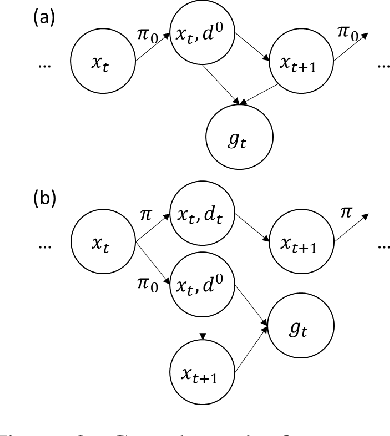


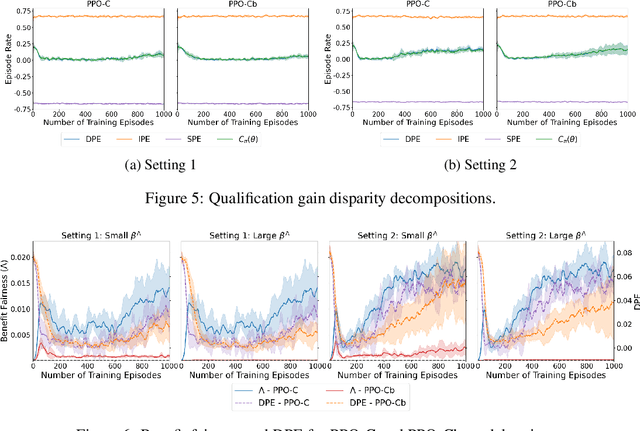
Abstract:Fairness-aware learning studies the development of algorithms that avoid discriminatory decision outcomes despite biased training data. While most studies have concentrated on immediate bias in static contexts, this paper highlights the importance of investigating long-term fairness in dynamic decision-making systems while simultaneously considering instantaneous fairness requirements. In the context of reinforcement learning, we propose a general framework where long-term fairness is measured by the difference in the average expected qualification gain that individuals from different groups could obtain.Then, through a causal lens, we decompose this metric into three components that represent the direct impact, the delayed impact, as well as the spurious effect the policy has on the qualification gain. We analyze the intrinsic connection between these components and an emerging fairness notion called benefit fairness that aims to control the equity of outcomes in decision-making. Finally, we develop a simple yet effective approach for balancing various fairness notions.
 Add to Chrome
Add to Chrome Add to Firefox
Add to Firefox Add to Edge
Add to Edge